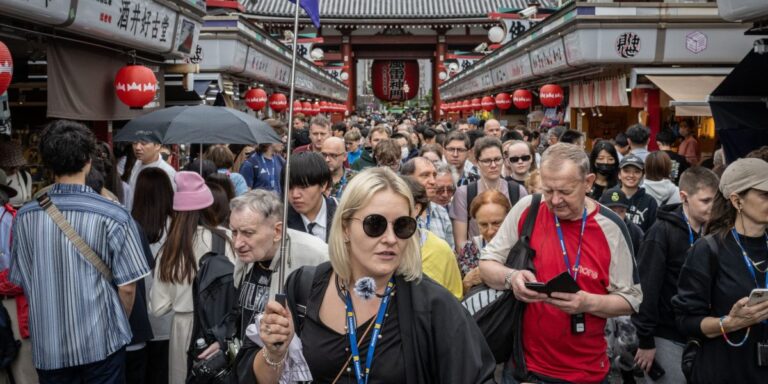According to data from the Japan National Tourism Organization, more than 14.6 million international tourists visited Japan from January to May. Some 3.1 million people visited Japan in March alone, the highest monthly total since records began in 1964.
If the trend continues, Japan will surpass the record number of tourists of 31.9 million recorded in 2019, just before the COVID-19 pandemic.
Total spending by tourists in Japan in the first quarter of this year reached 1.75 trillion yen ($10.8 billion), making tourism Japan’s second-largest “export” after autos and ahead of manufactured goods such as semiconductors, according to calculations by Fortune and data from Oxford Economics.
Norihiro Yamaguchi, senior Japan economist at Oxford Economics, noted that this is the first time tourism spending has ranked second since the fourth quarter of 2019. Inbound travel to Japan nearly disappeared during the pandemic but recovered quickly after Japan began easing COVID-19 measures in September 2022. Japan lifted all restrictions in April 2023.
The yen has hit a record low against the U.S. dollar, giving tourists more purchasing power in Japan, making hotel prices, sightseeing and family meals cheaper for foreign visitors than they were before the pandemic.
But Jeremy Beck, global head of Japanese travel platform Rakuten Travel, believes the surge in tourism to Japan is not just down to a weak currency.
Tourists now want more than just food and shopping; they want unique experiences they can post on social media. “It’s an Instagram culture, you know?” Beck says. “It’s not about what you eat or what you do, it’s about showing people what you eat and what you do. And Japan is a beautiful country. There are so many beautiful things to Instagram.”
What effect does the weak yen have on the tourism industry?
The yen, long used as a safe haven by investors in times of crisis, has fallen against the dollar, trading at around 161 to the dollar from 140 a year ago.
The Federal Reserve’s “higher for longer” stance has made the U.S. dollar more attractive to investors, putting pressure on many Asian currencies.
Japan has resisted raising interest rates in its decades-long battle with deflation, and the Bank of Japan has kept its key interest rate in negative territory even as other central banks seek to follow their U.S. counterparts in a rate-hiking cycle from 2022 to mid-2023.
In March, Japan’s central bank raised interest rates above zero for the first time in 17 years. The hike came after Japanese companies agreed to big wage increases, raising hopes that Japanese consumers might increase spending and jump-start the economy.
Japanese companies have generally viewed a weaker yen as a good thing because it lowers the cost of exports and increases the value of profits remitted overseas, but now the yen may be unfavorably weak for them as expensive imports eat into profit margins and depress consumer spending.
Even Japan Airlines, which derives its revenue from the travel industry, is growing wary of the weak yen as it makes overseas travel prohibitively expensive for many Japanese.
Why is Japan complaining about overtourism?
Rakuten Travel is benefiting from Japan’s travel boom: Bookings in the first quarter of 2024 are up 75% compared to the same quarter in 2019, before the COVID-19 pandemic, according to Beck. Total transaction value is also up 200% over the same period.
Most of the tourists come from South Korea, mainland China, Taiwan and Hong Kong, according to Japanese government data.
Beck said tourists are looking for more authentic, all-round experiences than the major tourist destinations of Tokyo and Osaka. Travelers are seeking experiences such as kaiseki cuisine, hot springs and nature experiences in second- and third-tier cities, and bookings for non-subway routes are surging faster than those for subway routes, Beck said, citing data from Rakuten Travel.
Some Japanese residents have complained about the surge in tourists, complaining about overcrowding and bad behavior. (Several other tourist destinations, such as Spain and Greece, have also experienced backlash against “overtourism.”)
In Kyoto, a major tourist destination, tourist complaints helped elect a mayoral candidate: Koji Matsui campaigned against overtourism, citing frustration at tourists pushing suitcases onto crowded public transport.
In another example, the Japanese town of Fujikawaguchiko erected barricades to block a popular photo spot on Mount Fuji after local residents were upset at the growing number of tourists littering, trespassing and breaking traffic rules in an attempt to take photos for social media.
But tourists continue to search for the perfect shot, with some even going so far as to cut holes in the fence to take photos, Beck said.
The influx of tourists has prompted some destinations and businesses to consider dual pricing, charging regular rates for Japanese residents and higher prices for tourists.
The city of Himeji is considering charging foreigners an extra fee to visit the 400-year-old UNESCO World Heritage Site Himeji Castle, ostensibly to cover the costs of necessary maintenance.
Kyoto Mayor Matsui is pushing for higher fares for tourists to ease the strain on public transport, and the city has also introduced express tourist buses that stop only at major tourist destinations.
But Beck believes concerns about overtourism are mainly limited to big cities like Tokyo, Kyoto and Osaka, as lesser-known cities are not yet “overpopulated,” he says.
Fortunately for tourists, Beck says the hotels he works with aren’t considering raising prices for foreigners. He points out that hotels still have enough rooms available to accommodate both foreign and domestic tourists. He believes that despite the travel boom, Japanese hotels are playing it safe when it comes to capacity.
“They don’t want a repeat of the COVID-19 situation,” he said, “where they’re so reliant on international tourists, and then when things shut down, they don’t have any customers.”

